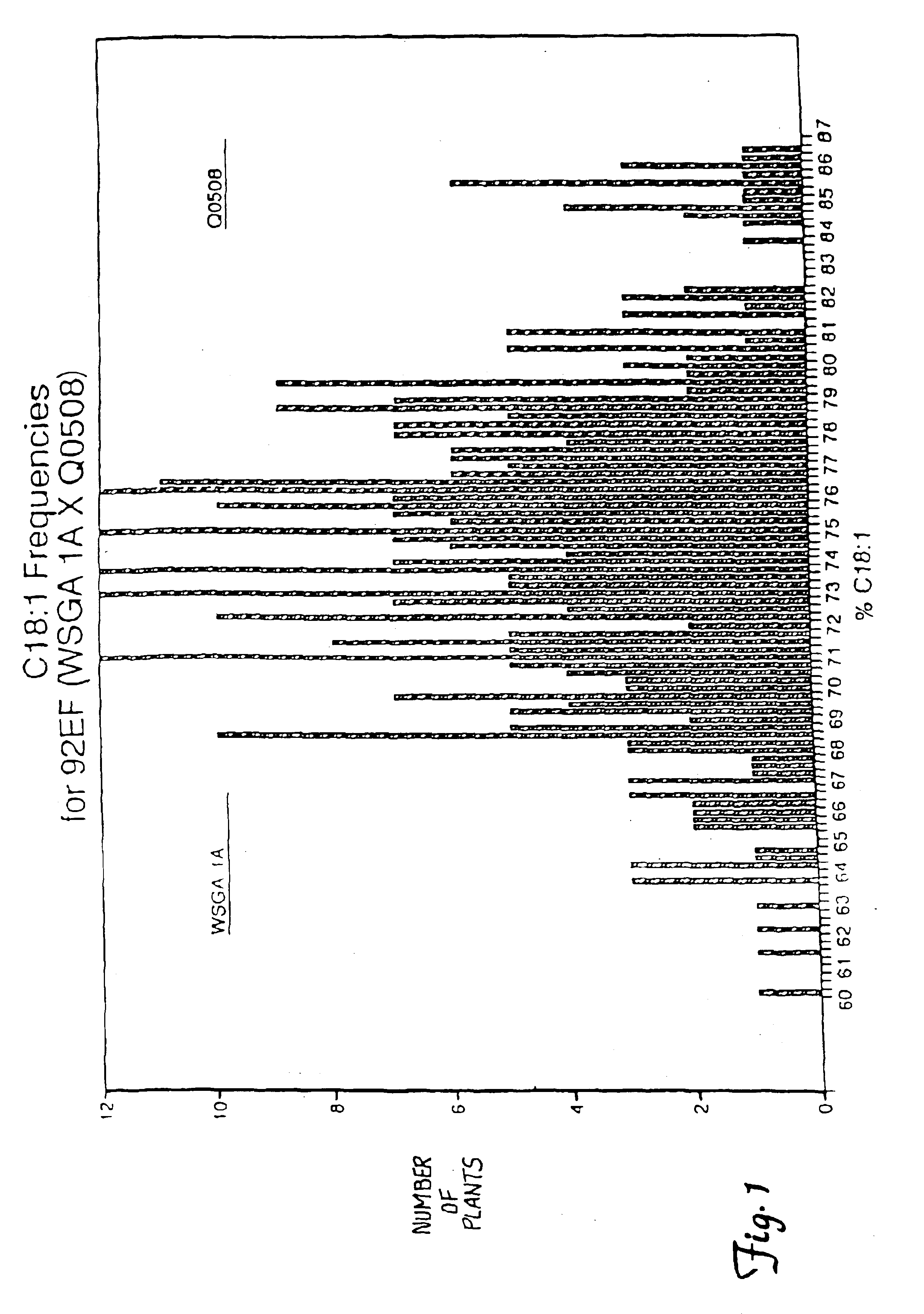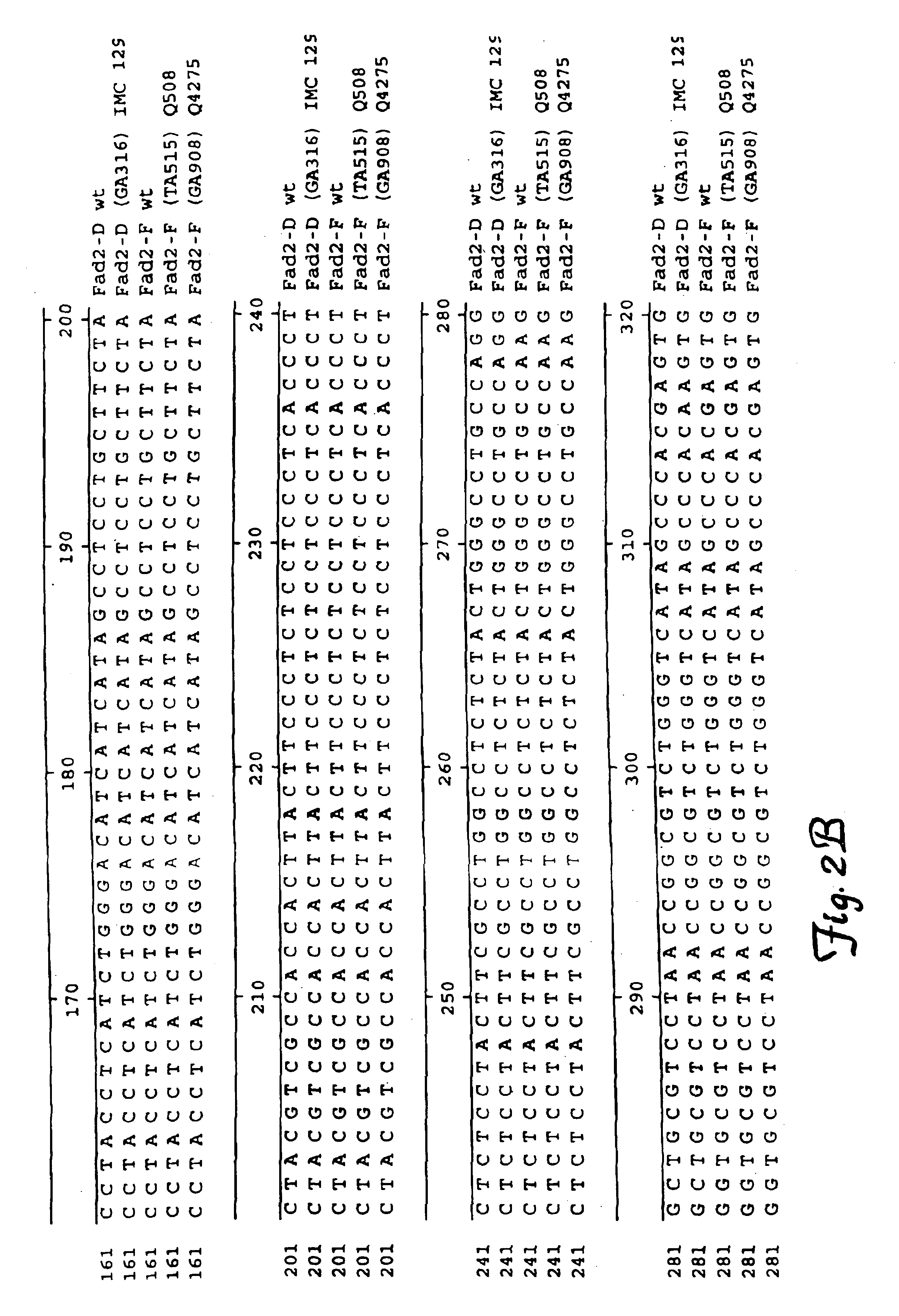Fatty acid desaturases and mutant sequences thereof
a technology of fatty acid desaturase and mutant sequences, which is applied in the field of fatty acid desaturases and nucleic acids encoding desaturase proteins, can solve the problems of low -linolenic acid mutation derived from the rakow mutation breeding program that did not have direct commercial application, and no teachings that disclose mutations in delta-12 or delta-15 fatty acid desaturase coding sequences from plants
- Summary
- Abstract
- Description
- Claims
- Application Information
AI Technical Summary
Benefits of technology
Problems solved by technology
Method used
Image
Examples
example 1
[0075]Seeds of Westar, a Canadian (Brassica napus) spring canola variety, were subjected to chemical mutagenesis. Westar is a registered Canadian spring variety with canola quality. The fatty acid composition of field-grown Westar, 3.9% C16:0, 1.9% C18:0, 67.5% C18:1, 17.6% C18:2, 7.4% C18:3, 22:1, has remained stable under commercial production, with <±10% deviation, since 1982.
[0076]Prior to mutagenesis, 30,000 seeds of B. napus cv. Westar seeds were preimbibed in 300-seed lots for two hours on wet filter paper to soften the seed coat. The preimbibed seeds were placed in 80 mM ethylmethanesulfonate (EMS) for four hours. Following mutagenesis, the seeds were rinsed three times in distilled water. The seeds were sown in 48-well flats containing Pro-Mix. Sixty-eight percent of the mutagenized seed germinated. The plants were maintained at 25° C. / 15° C., 14 / 10 hr day / night conditions in the greenhouse. At flowering, each plant was individually self-pollinated.
[0077]M2 seed ...
example 2
High Oleic Acid Canola Lines
[0091]In the studies of Example 1, at the M3 generation, 31 lines exceeded the upper statistical threshold for oleic acid (≧71.0%). Line W7608.3 had 71.2% oleic acid. At the M4 generation, its selfed progeny (W7608.3.5, since designated A129.5) continued to exceed the upper statistical threshold for C18:1 with 78.8% oleic acid. M5 seed of five self-pollinated plants of line A129.5 (ATCC 40811) averaged 75.0% oleic acid. A single plant selection, A129.5.3 had 75.6% oleic acid. The fatty acid composition of this high oleic acid mutant, which was stable under both field and greenhouse conditions to the M7 generation, is summarized in Table 9. This line also stably maintained its mutant fatty acid composition to the M7 generation in field trials in multiple locations. Over all locations the self-pollinated plants (A129) averaged 78.3% oleic acid. The fatty acid composition of the A129 for each Idaho trial location are summarized in Table 10. In multiple locat...
example 3
Low Linoleic Acid Canola
[0102]In the studies of Example 1, at the M3 generation, 80 lines exceeded the lower statistical threshold for linoleic acid (≦13.2%). Line W12638.8 had 9.4% linoleic acid. At the M4 and M5 generations, its selfed progenies [W12638.8, since designated A133.1 (ATCC 40812)] continued to exceed the statistical threshold for low C18:2 with linoleic acid levels of 10.2% and 8.4%, respectively. The fatty acid composition of this low linoleic acid mutant, which was stable to the M7 generation under both field and greenhouse conditions, is summarized in Table 13. In multiple location replicated yield trials, A133 was not significantly different in yield from the parent cultivar Westar. An additional low linoleic acid line, designated M3062.8 (ATCC 75025), was also produced by the disclosed method. A 10-seed bulk analysis of this line showed the following fatty acid composition: C16:0—3.8%, C18:0—2.3%, C18:1—77.1%, C18:2—8.9%, C18:3—4.3%, FDA Sats—6.1%. This line has ...
PUM
| Property | Measurement | Unit |
|---|---|---|
| ionic strength | aaaaa | aaaaa |
| pH | aaaaa | aaaaa |
| pH | aaaaa | aaaaa |
Abstract
Description
Claims
Application Information
 Login to View More
Login to View More - R&D
- Intellectual Property
- Life Sciences
- Materials
- Tech Scout
- Unparalleled Data Quality
- Higher Quality Content
- 60% Fewer Hallucinations
Browse by: Latest US Patents, China's latest patents, Technical Efficacy Thesaurus, Application Domain, Technology Topic, Popular Technical Reports.
© 2025 PatSnap. All rights reserved.Legal|Privacy policy|Modern Slavery Act Transparency Statement|Sitemap|About US| Contact US: help@patsnap.com



